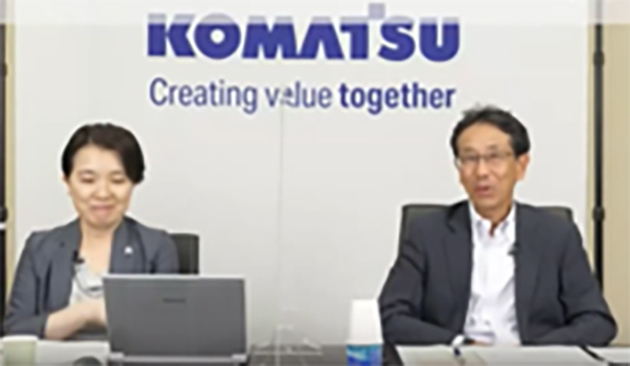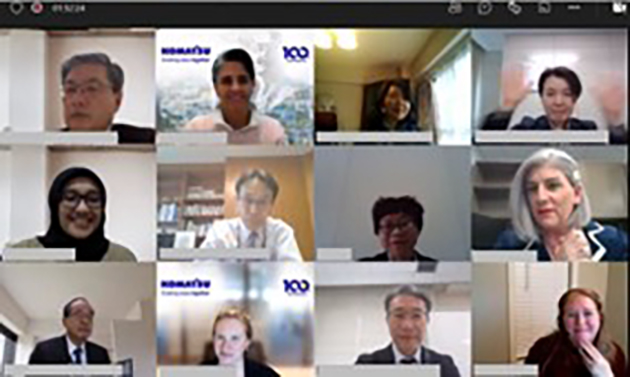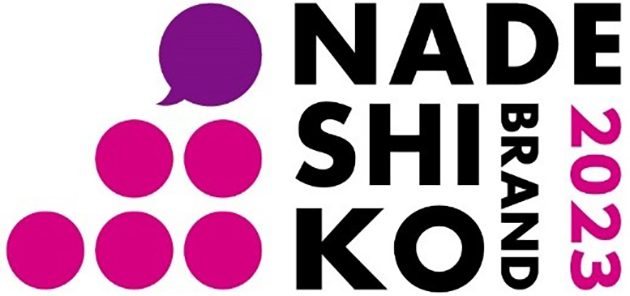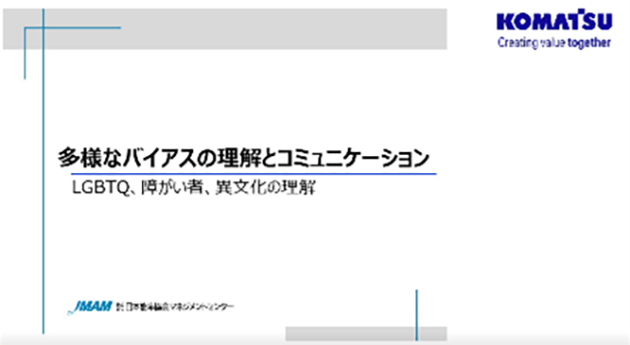In growth strategies of the mid-term management plan, Komatsu set "enrich human resources base with diversity" as a priority activity, alongside promoting the "enhancement of diversity & inclusion" initiatives. We believe it is possible to create an environment where diverse employees can benefit from identifying each colleague’s individuality and abilities. Doing so will enable teams to maximize each other’s abilities to achieve a collaborative atmosphere where everyone plays an active role in enhancing systems to support diverse work styles and work-life balance. Ultimately, this will lead to the realization of a workplace where employees can feel secure and be innovative as they make contributions to company growth, so we continue to promote these initiatives.
With foreign employees accounting for approximately 70% of our workforce, Komatsu has been promoting the localization of management. Among them, we have appointed the heads of major overseas subsidiaries as Global Officers, who are responsible not only as regional heads but also as executives of the Komatsu Group. Plus, we have also appointed those employees tasked with facilitating the management of the Komatsu Group as executive officers. Komatsu has created approximately 750 "Global Key Positions" in Japan and overseas and developed a succession plan for these positions. We are also aiming to foster the systematic cultivation of next-generation leaders who will be responsible for global management through programs such as the “Global Management Seminar” for management-level employees and candidates, and “KOMATSU Way Leadership Development Training” for mid-level employees.
Additionally, Komatsu trains engineers who provide continuous product support at customers’ sites around the world. The Komatsu Philippines Corporation, a specialized educational institution, has trained over 150 engineers. Graduates of the training program, which lasts about six years, are subsequently employed as “global engineers” and work around the world.
As part of our gender diversity initiatives, we have set a global KPI (ratio of women employed: 17.0%; ratio of women in management positions: 13.0% on a global consolidated basis by the end of FY2024) for our mid-term management plan. Also, we are proactively recruiting women, providing training programs for their systematic development, creating favorable environments for continuous career development, and actively supporting appointments to more responsible positions of high authority. As various measures to promote the advancement of women will lead to the creation of environments where all employees can work comfortably and feel empowered to maximize their abilities, we will continue to promote group-wide activities.



Our strategy also includes working on "D&I literacy improvement activities" to foster employees' awareness, which incorporates the conducting of promotional activities via the distribution of videos and columns on D&I. Additionally, to encourage female employees to improve their career aspirations, a "D&I Talk Event" has been held since FY2022, which allows for posing direct questions to management and, for the first time, has included interactions with the president and female executives. The event received high satisfaction ratings from employees who benefitted from the opportunity to hear the thoughts and encouragement of management as they considered their own career pathways. We will continue to implement our existing measures for female employees, which will include career plan training, networking workshops, external training, and the Diversity & Inclusion Development Seminar (DIDS: a seminar for female managers at Komatsu and its overseas subsidiaries focused on developing female executives capable of implementing managerial decisions rooted in the Komatsu Way, at the same time as promoting gender diversity among future senior management). In recognition of these efforts, Komatsu was selected as one of the Nadeshiko Brand for FY2022 by the Ministry of Economy, Trade and Industry in collaboration with the Tokyo Stock Exchange – these organizations jointly select companies that excel in promoting women's activities. (One company from each industry is selected from approximately 3,700 listed companies of 17 industries.)
| Total | Female employees (Female employees percentage) |
Non-Japanese employees (Non-Japanese employees percentage) |
Mid-career employees (Mid-career employees percentage) |
||
|---|---|---|---|---|---|
| Directors and Global officers | 64 | 2 (3.1%) |
19 (29.7%) |
14 (21.9%) |
|
| Executive officers (Domestic) | 30 | 2 (6.7%) |
0 (0.0%) |
2 (6.7%) |
|
| Management position | 1,854 | 149 (8.0%) |
13 (0.7%) |
361 (19.5%) |
|
| General managers | 403 | 12 (3.0%) |
0 (0.0%) |
44 (10.9%) |
|
| FY2020 | FY2021 | FY2022 | ||||
|---|---|---|---|---|---|---|
| Global (Consolidated) | ||||||
| Ratio of women employed | 13.6% | 13.9% | 14.1% | |||
| Ratio of women in management positions | 9.5% | 10.0% | 10.3% | |||
| Komatsu Ltd. (Non-consolidated) | ||||||
| Number (ratio) of women employed | 1,443 (12.3%) |
1,451 (12.4%) |
1,507 (12.3%) |
|||
| Number (ratio) of women in management positions | 300 (9.3%) |
312 (9.2%) |
341 (9.5%) |
|||
| Number (ratio) of women managers | 128 (7.5%) |
135 (7.8%) |
149 (8.0%) |
|||
| Number (ratio) of women junior managers | 172 (11.2%) |
177 (10.8%) |
192 (11.0%) |
|||


In "KOMATSU'S WORLDWIDE CODE OF BUSINESS CONDUCT" October 2017 revision, we stipulated the prohibition of unfair discrimination against sexual minorities (not only nationality, race, religion, age, sex, presence or absence of disability, but also sexual orientation and gender identity) as sexual harassment including discriminatory remarks subject to disciplinary action. In addition to implementing a number of initiatives – such as the setting up of an in-house counseling desk for LGBTQ individuals, the certification of same-sex partnerships, and the expansion of welfare benefits – we are also working to promote an understanding of LGBTQ issues and to create a comfortable work environment for everyone that utilizes e-learning, online seminars for managers, and the distribution of training videos to all employees.
At Komatsu Group, we are committed to eliminating and preventing all forms of discrimination and harassment. Each of our business locations has a designated harassment consultation desk, and we have established a system to promptly address issues as they arise. When consultations are received, we conduct investigations with utmost respect for the privacy of the individual seeking guidance, implement any necessary corrective measures, and take action to prevent recurrence, while also providing follow-up support to the person who raised the concern. Additionally, we regularly conduct anti-discrimination and harassment prevention training for employees at all levels. This fosters a deeper understanding of discrimination and harassment issues among our staff, encouraging empathy and consideration for each other’s positions, and contributing to the creation of a safe and healthy work environment.
| Number of harassment-related reports received (in Japan) | 40 |
| Anti-discrimination and harassment prevention training (in Japan) (e-learning and group learning) |
|
Komatsu actively seeks to employ persons with disabilities across the Group. Our goal of a KPI in the mid-term management plan is to achieve the employment ratio of 2.5% on a consolidated basis by 2024 for the Group in Japan.
In March 2008, Komatsu established the Business Creation Center (BCC) within the Human Resources Department in Japan as a dedicated organizational entity for promoting the hiring of persons with disabilities. Persons with mental or developmental disabilities are employed by the BCC in eleven business units in Japan. By having BCC perform previously outsourced operations and desk work, BCC can expand its job scope and improve the efficiency of the company as a whole. Advisors are assigned to each business unit to provide training and advice on daily tasks. Each BCC staff member meets with an advisor every six months to discuss goals, instead of simply handling a delimited set of tasks. Linking salary to individual performance assessments, we encourage employees with disabilities to work on their goals toward achieving independence and self-reliance. Through these efforts Komatsu is not merely focused on achieving a targeted employment ratio. Rather, it is seeking to create a workplace that provides a sense of fulfillment for all individuals, where employees with disabilities work alongside other staff members.
| FY2020 | FY2021 | FY2022 | |
|---|---|---|---|
| Employment ratio of persons with disabilities | 2.82% | 2.84% | 2.73% |
| Number of BCC locations | 11 | 11 | 11 |
| Number of BCC staff members | 144 | 156 | 165 |
As Japan’s birthrate declines and its population ages, we believe that efforts to improve employee productivity across all generations and to strengthen our older workforce are not only a response to societal realities but also a way to ensure our sustainable growth. Komatsu has been promoting initiatives to achieve the above, including the introduction of a post-retirement reemployment system in 2006 and the reemployment of all applicants up to the age of 65 (for general employees) since 2013. In 2021, Komatsu implemented an optional retirement age system for the entire Komatsu Group in Japan, which allows employees to choose the maximum retirement age of 65. Moreover, Komatsu is expanding its support framework to enable employees to continue to work at Komatsu and realize their optimal work styles based on their values by providing training opportunities for employees to reflect on their career and life, a paid leave system for skills development, and a financial aid system.
| Systems and Measures | Content |
|---|---|
| Selective Retirement System | Employees can choose to retire at age 60, 62 (management), or 65 (general employees). Employees who choose to retire at age 62 or 65 receive the same benefits as those who retire before age 60. |
| Part-time Work System | This system allows employees to work part-time when they choose to retire at age 60 or 62 and are rehired after retirement. Working hours can be set from 1/2 to 3/4 those of full-time employees and working hours per day and working days per week can be decided. |
| Second Job System | Part-time employees who have been rehired after retirement can work a second job under certain conditions to support their careers. |
| Career Support System | (1) Career Life Plan Seminar All employees aged 45 and older are encouraged to develop an independent and autonomous career vision by considering their work prospects, work style, lifestyle, and financial plan. (2) Outplacement Support System A skills development leave system and outplacement services for employees aged 50 and over who want to progress their careers outside the company. |
| FY2020 | FY2021 | FY2022 | |||
|---|---|---|---|---|---|
| Reached age 60 | 201 | 252 | 355 | ||
| Continued employment after age 60 | 174 | 216 | 325 | ||
| Chose to retire at age 62 or 65 | - | 202 | 292 | ||
| Rehired after retirement at age 60 | 174 | 14 | 33 | ||
| Retired at age 60 (Retirement rate at age 60) |
27 (13.4%) |
36 (14.3%) |
30 (8.5%) |
||
To support employees to pursue diverse work styles, we promote flexible and autonomous working that is not restricted by location or time. This includes the expansion of the “telework system” in FY2020 to allow employees to continue their careers and improve productivity and the abolition of core hours in the “flextime system” in FY2021.
| Main System and Measures | Content | |
|---|---|---|
| Creation of diverse work styles | Flextime system | Flexible work hours (5:00~22:00) with flexible start and end times (no core time). |
| Discretionary work system | A work system for employees who engage in highly discretionary work, such as R&D. Under this system, employees can execute their work at their discretion. | |
| Telework system | Work from home as often as desired to support career continuity and increased productivity. Telework allowance paid. | |
Komatsu promotes work-life balance among its employees by reducing total working hours and establishing various support systems. To reduce working hours, Komatsu has worked with the labor union to set the targets of “less than 2,100 working hours per year and at least 20 days of annual paid leave for all employees” based on the 36 Agreement. Moreover in the development of our employee systems, we promote initiatives to not only help employees achieve a work-life balance but also safe and healthy work styles, for example, using the “Interval System” between workdays.
We have also expanded our safety net by providing more leave and leave of absence than legally required to cover childcare, family care, and personal injury or illness. Furthermore, we have implemented, a “Life Support Leave” system that can be used for various life events in addition to annual paid leave. To complement these efforts, we have implemented support measures to create an environment that allows employees to use our systems and measures easily according to their circumstances.
| Systems and Programs | Content | |
|---|---|---|
| Child-care system | Child-care leave | Available for a maximum of three years from the birth of the child to the time the child enters nursery school (the statutory leave period is up to 18 months without pay). Also available for a maximum of three years for children up to the third grade of elementary school in cases where a spouse is transferred, etc. Paid leave is available until the child is 2 years old and can be taken in installments. |
| Part-time work | Shortening of working hours by a maximum of three hours per day to allow for the care of children until the child graduates from elementary school (statute allows this only for children under three years old). Split-time acquisition is possible. | |
| Paternity leave | Up to 4 weeks (28 days) within 8 weeks after the birth of a child is available and can be taken in installments. Paid leave is available until the child is 2 years old. | |
| Allowance toward the cost of using child-care services | Allowance toward the cost of childcare for infants up to age two before entering nursery school (10,000 yen/month). | |
| Child-care leave | Five days for the nursing care of one child up to the third grade of elementary school and ten days for the second child onward (paid leave). (statute allows this only for children up to the first grade of elementary school.) | |
| Childcare facilities and allowance | A nursery school fee subsidy system, childcare services, and on-site day-care facilities are available. Additionally, health management rooms located at each site offer private rooms for childcare and multipurpose use such as freezing breast milk. | |
| Family-care system | Family-care leave program | A maximum of three years is available for employees taking care of family members, which can be taken in installments. Paid leave is available for a total of 93 days. (the statutory leave period is a total of 93 days without pay). |
| Part-time work | Shortening of working hours by a maximum of three hours per day, which can be taken for up to three years in total and can be taken in installments. | |
| Family-care leave | Five days per year for attending to one family member in need of nursing care, and ten days for the second family member onward (paid leave). | |
| Other types of leave system | Paid vacation | Statutory annual paid leave is granted for 10 days per year if the attendance rate is 80% or more at the end of the first 6 months of employment Komatsu grants 20 days per year from the time of joining the company (in principle). Leave can be taken in half-day increments. |
| Life support leave | Can be used as sick leave, pregnancy leave, child-care leave or for care of family members. An employee may add five new days of accumulated leave per year. A maximum of 40 days of unused annual leave may be accumulated. Child-care leave may be used for school events for children aged up to third grade in junior high school. | |
| Flexible leave for refreshment | Provided to encourage employees to take five consecutive days of leave for mental and physical refreshment. Employees receive an additional five days of annual leave and a travel voucher upon completion of their 15th, 25th and 35th year of continued service. |
|
| Interval system | To provide rest time after the end of the workday to ensure that employees can sleep and enjoy personal time. Provisions to ensure at least 10 hours between shifts (interval). | |
| Volunteer incentive program | Long-term paid leave of up to two years, or short-term paid leave of 12 days per year. | |
| Spousal transfer occupational leave system | Acquisition for up to three years per spousal transfer (Acquisition up to one per employee). | |
| Leave for infertility treatment | Each employee is permitted leave of up to a whole year for infertility treatment. | |
| Part-time work for personal injury or illness | Up to 3 hours per day (up to 5 hours per day if approved by the company under special circumstances) for periodic hospital visits due to personal injury or illness; these can be taken for up to 6 months. | |
| Support and Measures | Content | |
|---|---|---|
| Child-care support | Childcare service during in-house training | Provision of childcare services during in-house training at the Komatsu Way Training Center (Komatsu City, Ishikawa Prefecture), a training facility that serves as a human resources development facility for Komatsu Group employees globally. |
| “Childcare Day” social event | Setting a monthly "Childcare Day" and holding a social event to provide a place for communication among employees raising children. | |
| Childcare support seminar for men | Childcare support seminars for men, to foster awareness of the need for active participation in childcare among male employees with children and to change the perceptions of their bosses and co-workers. | |
| Family-care support | Family-care seminar | Seminar held by experts to provide opportunities for employees to think about how to prepare for family-care and how to balance their work and personal lives. From FY 2020, the seminar has been held online to increase awareness of family-care among a wide range of employees across Japan. |
| Individual consultation | Individual consultations with external experts have been held monthly to provide tailored for employees. | |
| Treatment support | Consultation service for balancing treatment and work | To support employees’ health and safety, a consultation desk has been set up at each site for those wanting to discuss balancing their medical treatment and work. We have also introduced various systems including fertility treatment leave to create a safe and secure working environment for those needing medical treatment. |
| FY2020 | FY2021 | FY2022 | |
|---|---|---|---|
| Number of employees taking childcare leave (total)*1 | 83 | 91 | 184 |
| Paternal leave | 36 | 49 | 121 |
| Maternal leave | 47 | 42 | 63 |
| Percentage of employees taking childcare leave (total)*1 | 15.7% | 16.7% | 34.5% |
| Paternal leave | 7.5% | 9.7% | 25.7% |
| Maternal leave | 100% | 100% | 100% |
| Return rate of employees from childcare leave | 98.8% | 98.4% | 99.9% |
| Number and percentage of employees taking leave or leave of absence, including those taking childcare-related leave other than childcare leave*2 | 337(70.3%) | 338(67.4%) | 361(76.9%) |
| FY2020 | FY2021 | FY2022 | |
|---|---|---|---|
| Family-care leaves | 7 | 3 | 7 |
| FY2020 | FY2021 | FY2022 | |
|---|---|---|---|
| Average days granted | 20.0 | 20.0 | 20.0 |
| Average days taken | 19.8 | 19.9 | 20.8 |
| Average ratio | 98.8% | 99.5% | 104% |
| FY2020 | FY2021 | FY2022 | |
|---|---|---|---|
| Number of VTO users | 14 | 27 | 32 |
| VTO in long-term | 0 | 0 | 0 |